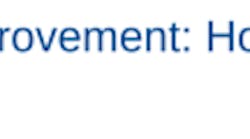Q1: Why is scheduled downtime not discounted? We are required to perform some maintenance off-line and also take the unit down when making a product change.
Even if every single competitor takes the same amount of downtime for those types of events, we still would not recommend discounting scheduled downtime as an impact to OEE. Why? Because reducing the number or length of scheduled downtime is a plus in being competitive. For example, you take a piece of machinery down to make a required oil change. But technology is now allowing oil changes to take place, in some cases, while machines are running. Would you have challenged this Scheduled Downtime event had the impact been removed from your OEE calculation? Our advice is to never discount events as they should continually be challenged to eliminate or reduce their effects on Availability. Are scheduled events better than unscheduled maintenance? Of course. This is why they are not recorded together. But the end result is still the same: a production hour lost to scheduled maintenance is equal to an hour lost to unscheduled maintenance. Let’s keep an eye on both for opportunities.
Q2: How do I weigh the impact difference between scheduled and unscheduled downtime?
Generally, the higher duration in time between scheduled and unscheduled will quickly tell you which one to focus on. However, if you want to see each one’s impact on OEE, enter zero for Scheduled Downtime and note the OEE. Then, restore the Scheduled Downtime number and replace the Unscheduled Downtime number with zero. This will tell you how much your Availability number will change based on which one you improve. Consider your improvement initiatives accordingly.
Q3: Our process runs more efficiently in the summer months because of weather temperatures. Can I adjust the Net Maximum Production down for the winter?
This is a reasonable request; however, do you have competitors in the south who don’t have the weather swing? If so, we would recommend not adjusting your Gross Maximum Production. There are inherent negative factors every plant must accept and will have to improve in other areas to remain competitive. Your customers will not pay you more because of your geographic weather disadvantage.
Q4: If I need to improve the Availability percentage, what are the next steps?
This is where more details are crucial. You will need to ask questions such as, “Are my downtimes equally scattered across all shifts, all days?” “What equipment in the process is triggering the downtimes?” “Have I done a critical equipment risk review and does this targeted equipment receive adequate PM/PdM attention?” “Do I track MTBF for the critical equipment?” After these questions are answered, you may wish to push into performing failure modes and effects analyses (FMEAs) and root cause failure analyses (RCFAs) on the identified equipment to detail what can be done to extend the run availability of the bad actors.
Q5: We run weekdays only, and can hold over people if we run short of product or schedule the crew for a Saturday. Does the need for a good OEE still exist?
No, not as much since you are not losing production. But, it is costing you more based on overtime, extended equipment operating costs, etc. And, if you use this condition as a crutch, you may begin slipping into further diminished efficiency as the equipment continues to deteriorate. The goal should be a good OEE number obtained from within the normal schedule. At some point you may want to look at a second shift because of increased demand. But if you were running well during the main shift, the second shift may not even be necessary!
To learn more, read "How (and why) to easily calculate your overall equipment efficiency."
Q6: Why is Rate the quiet negative for OEE?
Mainly because it silently sneaks into a process. It’s not dramatic like a failure. It usually occurs over many years: the equipment becomes older, the operators have a favorite/comfortable speed, or there is a demonstrated improvement in Availability when the rate is reduced. The solution is to look at the nameplate capacity. What was the machine designed to do, and what do I need to do to return to this condition? The other factor is "best demonstrated rate," which may be higher than the nameplate. If a Gross Maximum Production improvement is made to a machine, the bar goes up and the max Rate calculation goes up.
Q7: We have a batch process for grade changes. Why should this impact my OEE Availability percentage? I can’t change my business!
Your difficulty is understandable. But if your competitor is able to make grade changes quicker or has longer run lengths, will the customer grant you some slack? The need is to focus on what you can change. I have seen a plant with more than 30 grades of paper and was constantly making grade changes, which impacted their OEE. They remained successful because their Rate and Quality during the runs were outstanding. When they ran, they ran near perfect with minimal downtime and at full speed. And they used Single Minute Exchange of Die (SMED) methodology to minimize grade change lost time. The point is, accept your given conditions when necessary, but focus on what you can do to offset them in other areas.
Q8: We have the benefit of being able to blend back bad quality product in our chemical plant. Why do I need to negatively impact my OEE?
The simple answer is when you lose product during the process because of Quality, it’s an OEE loss. You’re fortunate that you can avoid scrapping the product by blending back, but the recycled product is displacing other first run quality product from being finished. However, you don’t have to take two OEE hits. Either capture the loss as a Quality percentage when it occurred, or record the loss as a Rate percentage loss when it is blended back in.
Q9: What is a good OEE percentage?
In general, a continuous process plant should see an OEE in the 90%+ range. Discrete manufacturing or batch plants should be in the 85%+ range. And it’s not easy. A score of 90% Availability, 90% Rate, and 90% Quality will only produce an OEE of 73%. But the return for improvement is significant. A medium-size chemical plant calculated an extra $2 million in net revenue for each 1% of OEE improvement.



